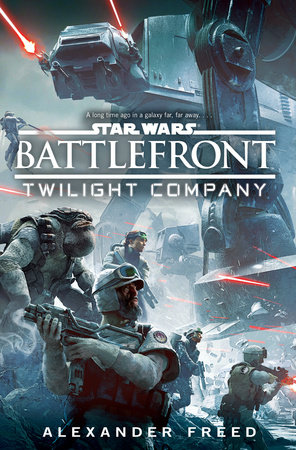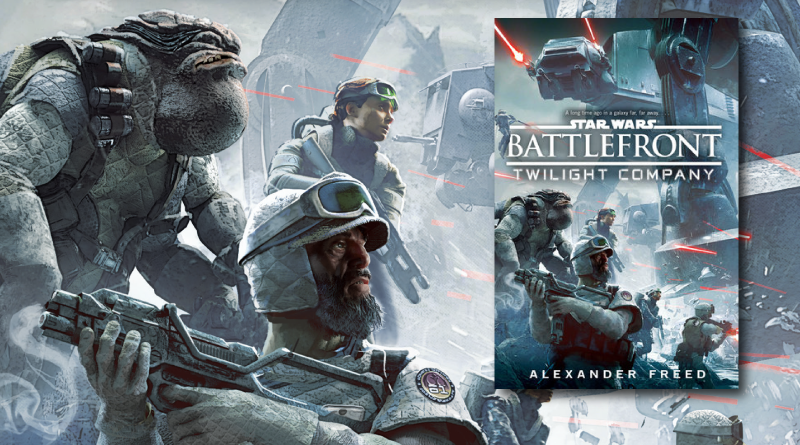Star Wars Battlefront: Twilight Company Review
 To be completely honest, I didn’t think Star Wars Battlefront: Twilight Company was going to be a book for me. The upcoming Battlefront video game looks interesting enough, but reading about ground battles is low on my list of what I look forward to when it comes to Star Wars. And for the first thirty or so pages, my lack of enthusiasm seemed well-placed. I just couldn’t get into it.
To be completely honest, I didn’t think Star Wars Battlefront: Twilight Company was going to be a book for me. The upcoming Battlefront video game looks interesting enough, but reading about ground battles is low on my list of what I look forward to when it comes to Star Wars. And for the first thirty or so pages, my lack of enthusiasm seemed well-placed. I just couldn’t get into it.
And then came a chapter from the perspective of a female Stormtrooper on Sullust. Overall Star Wars books have not provided all that much stormtrooper perspective. So between the way we are first introduced to SP-475 and the fact that this character has ties to the local population while also being dedicated to her job, it felt refreshing.
What’s more, SP-475 is not the only female character in the book. From large roles to the briefest of mentions there are so many females interspersed throughout the story that I lost count. In that Twilight Company reveals itself to be a testament to the storytelling that can take place when all the weight of female representation doesn’t sit on just one character’s shoulders. All of these women have more room to breathe, to be different, and, most importantly, to be people. What’s remarkable about the women in the book is that, in their world, being a woman in those roles isn’t remarkable. It’s something that has been slowly appearing in more and more Star Wars books and it makes the galaxy far, far away seem that much more real.
So for me, it was the characters that pulled me through the story more so than the plot, action, or outcomes. SP-475’s arc turns out to be not that astonishing, and a few of the other recurring characters I had a harder time keeping straight who was who (male and female alike). There are stand-outs, though. These include Twilight Company members Brand, Namir, and Howl as well as Imperial Governor Chalis.
Brand is a former bounty hunter who happens to be a woman of color and an example of a real strong female character. She is distinct and complex. She is able to transfer the skills of her past to her current role and manages to find a balance between the independent, solitary life that suited her well and being part of a team. She’s important to the group without having to be the stereotypical badass charging ahead imploring everyone to follow her. The way author Alexander Freed manages to show the reader Brand’s humanity without undermining her woman-of-few-words persona is especially appreciated.
More of Twilight Company is told through the perspective of Namir than any other character. His arc develops nicely save for the way we find out about his past. Those sections don’t add enough that we can’t already get from his present to make up for all the extra pages it fills and the way it makes the timeline of the book that much harder to keep track of. Like Brand, he’s more than one note though. Despite being most comfortable when he’s fighting on the front lines, he has moments of softness and questioning that make him no less of a valuable asset to his company and the story.
Howl is the founder of Twilight Company and provides a strangely welcome element of whimsy along with his philosophies on war. Although he serves as a window into part of the Rebellion’s military tactics and command structure, his ability to impact the story when he’s not even on the page rivals the intriguing qualities of his appearances. And it’s his decisions that bring Governor Chalis into the fray. Meanwhile Chalis brings with her connections to the previous new canon entry A New Dawn. Furthermore this is done in a way that doesn’t sound as much like name-dropping as many of the references from other recent Star Wars books do. It serves as a starting point to understand what kind of minds she’s used to dealing with without leaving a reader totally lost if they’re unfamiliar.
Chalis’ motivations are questionable and she’s kept at a certain distance from the reader, but her mysterious aspects aren’t what define her. Freed shows us she’s clever without resorting to making her an evil genius. She’s formidable while simultaneously being clearly dependent on certain members of Twilight Company. Not quite an antihero, Chalis is more of a looming potential threat to everyone regardless of what side they’re on in the war.
Speaking of the war, the book uses a dateline-type structure at the beginning of each chapter to let the reader know when and where the following events take place. The reference points aren’t stable, though, so for me, the location was the only part that helped. For example, being told you’re so many days before a certain operation when you don’t even really know what that operation is can make for more confusion than clarity.
Twilight Company does cross paths with the Battle of Hoth and I have to hand it to the Lucasfilm Story Group for having so many recent books cover that territory without conflicting with each other. Additionally it does actually feel like the other stories could be taking place just off-screen/off-page. That being said, I feel like I never need to read about the Battle of Hoth ever again. This is also one of those instances where crossing well-known movie territory pulls the tension out of a scene.
As much as I liked many of the characters and Freed succeeded for the most part in making the battles fairly easy to visualize, Twilight Company felt like it was never going to end. To be fair, it is a rather lengthy book at nearly 400 pages. There’s a bit of meta to that as the soldiers feel like the war might never end too. I’m a fast reader but found myself needing to take long breaks from it. But there are worse problems a book can have.
Ultimately, Star Wars Battlefront: Twilight Company was more of an enjoyable read than I expected. So for those who were unsure about this one, you might still want to give it a try. While there are a few graphic moments to remind you of the atrocity of war, the book is not excessively violent or gory. I’m not going to be shoving this book into everyone’s hands, but Twilight Company is definitely one of the better post-2013 Star Wars book releases.
The publisher provided FANgirl Blog a copy of this book.
- Review: Doctor Aphra, An Audiobook Original (Star Wars) - July 26, 2020
- Review: Bonds of Brass by Emily Skrutskie - April 7, 2020
- Review: The Art of The Rise of Skywalker - March 31, 2020












Hi Kay. I enjoyed your review. I found your thoughts on the characters interesting. I’m currently struggling to get through Twilight Company myself. I’m a fan of Star Wars novels and have been reading them for decades. There are good SW books and some not so good, but I’ve never found any of them boring until now. I too felt like Twilight Company was never going to end. I keep checking to see how many pages are left…that’s not typical of me. I am also having trouble connecting with the characters. I’m not concerned for their welfare and I’m not engaged in the story as a whole, which makes me zone out and I have to go back and read what I’ve missed. I thought it was the writing, but maybe it’s just me—maybe Twilight Company just isn’t my cup of tea.
Pingback:Recalling Star Wars Books with Nerd Lunch – FANgirl Blog